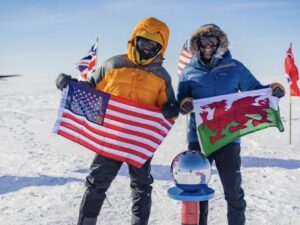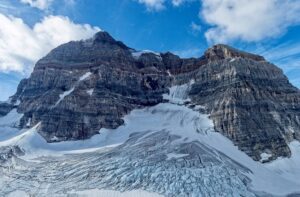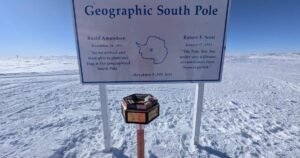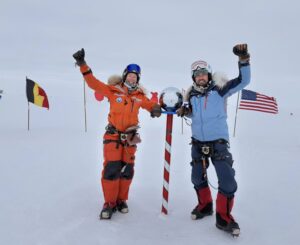Discoveries by Scientists
Fruit cake is a not only today a calorie-packed menu item for polar adventurers, also 100 years ago it was taken to Antarctica, as discovered by the Antarctic Heritage Trust. Mount Sidley is the highest volcano on Antarctica, but apart from the known volcanoes seen above the ice, scientists have reportedly discovered 91 below the ice.
Fruit Cake
The New Zealand Antarctic Heritage Trust conservators found a 100 year old fruit cake among the artefacts from Cape Adare. They reported in a press release, the fruit cake, made by Huntley & Palmers, is still wrapped in paper and encased in the remains of a tin-plated iron alloy tin. The cake probably dates to the Cape Adare-based Northern Party of Scott’s Terra Nova expedition (1910 – 1913) as it has been documented that Scott took this particular brand of cake with him at that time.
Although the tin was in poor condition, the cake itself looked and smelt (almost) edible. Conservation treatment involved rust removal, chemical stabilisation and coating of the tin remnants. Deacidification of the tin label and some physical repair to the torn paper wrapper and tin label was also carried out. The cake itself was in excellent condition. Programme Manager-Artefacts Lizzie Meek said “With just two weeks to go on the conservation of the Cape Adare artefacts, finding such a perfectly preserved fruitcake in amongst the last handful of unidentified and severely corroded tins was quite a surprise. It’s an ideal high-energy food for Antarctic conditions, and is still a favourite item on modern trips to the Ice.” Since May 2016, a team of four conservators have been working in the Canterbury Museum lab on the conservation of Antarctic artefacts from Cape Adare. The team recently finished the large project in July this year, conserving almost 1500 artefacts.
The Trust is now planning to begin the conservation work on the buildings at Cape Adare. The huts were built by Norwegian Carsten Borchgrevink’s expedition in 1899 and later used by Captain Scott’s party in 1911. The buildings were the first in Antarctica and are the only examples left of humanity’s first building on any continent. The permit the Trust was granted to collect the artefacts stipulates that all of the items must be returned to the site following conservation, in accordance with the site’s status as an Antarctic Specially Protected Area (ASPA). This will happen once the huts themselves have been restored.
Borchgrevink’s Hut
Courtesy Antarctica Heritage Trust: Commander Carsten Borchgrevink, a young Norwegian, and his crew sailed from London to be the first to spend a winter in Antarctica. On 17 February 1899, Horchgrevink’s British Antarctic (Southern Cross) Expedition landed at Cape Adare, one of the most inhospitable sites on earth, and set up base. The expedition erected two modest timber huts – a living hut, and a stores hut – that came as a kit from Norway. Today, the huts are surrounded by boxes, sacks of coal, barrels and other miscellaneous stores. The roof of the stores hut was removed in 1900 before the expedition left. It is a tribute to the solidity of their construction that both remain in surprisingly good condition. Many of the original contents remain intact inside the living hut. The fitted bunks are all still there, the original stove, and many of the stores, clothing and papers are in good condition. The remnants of Borchgrevink’s expedition were overlaid by the use of the hut for most of 1911 by the six members of the Northern Party of Scott’s British Antarctic Expedition.
Previous on Pythom:
118-year-old painting discovered on Antarctica
Volcanoes
In addition to the already 47 known volcanoes on Antarctica, Scientists have discovered another 91 below the Antarctica ice sheet, reported The Guardian in a debrief of a study published in the Geological Society Special Publications series. The volcanoes range in height from 100m to a towering 3,850m. All are covered in ice, which sometimes lies in layers that are more than 4km thick in the region. These active peaks are concentrated in a region known as the west Antarctic rift system, which stretches 3,500km from Antarctica’s Ross ice shelf to the Antarctic peninsula. Read more here.
Previous on Explorersweb:
AGAP Antarctica findings: Gamburtsev’s ghost mountains lived twice
Subglacial Lake
“Near the South Pole, a large subglacial lake exists beneath the East Antarctic Ice Sheet less than 10 km from where the bed temperature is inferred to be −9°C. A thermodynamic model was used to investigate the apparent contradiction of basal water existing in the vicinity of a cold bed. Model results indicate that South Pole Lake is freezing and that neither present-day geothermal flux nor ice flow is capable of producing the necessary heat to sustain basal water at this location.” More info in the article Ice-flow reorganization within the East Antarctic Ice Sheet deep interior published by the Geological Society of London.
#polar #Antarctica #fruitcake # Volcanoes#






